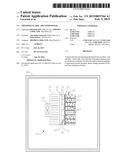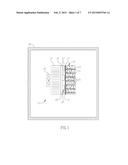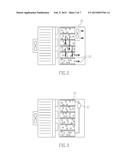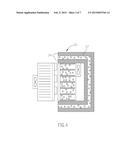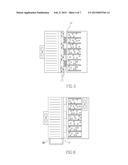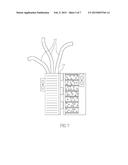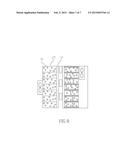Patent application title: THERMOELECTRIC AIR CONDITIONER
Inventors:
David Klein (Rehovot, IL)
Alexander Gurevich (Petah Tikva, IL)
Isaac Steiner (Tel Aviv, IL)
Assignees:
DOUBLE COOL LTD.
IPC8 Class: AF25B2102FI
USPC Class:
62 36
Class name: Using electrical or magnetic effect thermoelectric; e.g., peltier effect interior of enclosure cooled; e.g., refrigerator
Publication date: 2015-02-05
Patent application number: 20150033764
Abstract:
A thermoelectric unit including thermoelectric modules, cold side fins, a
heat sink, a hot side heat absorption element, and an electronic
controller. The heat absorption element includes a metal heat transfer
structure, phase change material (PCM) and heat exchange medium.Claims:
1. Apparatus comprising: a thermoelectric unit comprising thermoelectric
modules , cold side cooling fins, a cold side heat sink, a hot side heat
absorption element, and an electronic temperature controller, wherein
said heat absorption element comprises a metal heat transfer structure, a
phase change material (PCM) and a fluid heat exchange medium which is a
liquid.
2. Apparatus according to claim 1, wherein said PCM comprises granules with length dimensions of 3-5 mm.
3. Apparatus according to claim 1, wherein said PCM has a single working temperature.
4. Apparatus according to claim 1, wherein said PCM comprises a mixture of materials with different working temperatures.
5. Apparatus according to claim 1, wherein said heat absorption element comprises a thermal insulating portion to prevent heat losses to surrounding space.
6. Apparatus according to claim 5, wherein said thermal insulating portion comprises a multiple layers with one or more layers of PCM as middle layers.
7. Apparatus according to claim 1, wherein said cold heat sink comprises a tank for condensed water collection.
8. Apparatus according to claim 1, further comprising manifold tubing for cold air distribution.
9. Apparatus according to claim 1, wherein said fluid heat exchange medium comprises a nanofluid.
10. Apparatus according to claim 9, wherein said nanofluid comprises PCM nano-particles with the same working temperature as the PCM.
11. Apparatus according to claim 9, wherein said nanofluid comprises a mixture of nanoparticles with different working temperatures.
12. Apparatus according to claim 1, further comprising a pump for pumping said liquid.
Description:
FIELD OF THE INVENTION
[0001] The present invention relates generally to thermoelectric air conditioning systems, particularly for temperature control of a confined space.
BACKGROUND OF THE INVENTION
[0002] Thermoelectric devices utilize the properties of certain materials to develop a thermal gradient across the material in the presence of current flow. For example, thermoelectric devices may utilize P-type and N-type semiconductors as the thermoelectric material within the device. These are physically and electrically configured in such a manner that they provide cooling or heating.
SUMMARY OF THE INVENTION
[0003] The present invention seeks to provide a novel thermoelectric air conditioner/dehumidifier (thermoelectric air conditioner, for short) for operating inside a confined space (such as, but not limited to, a protective suit, sealed enclosure, closed room, and many others) without external power source, as is described more in detail hereinbelow.
[0004] The thermoelectric unit comprises, without limitation, thermoelectric modules, cold side fins, heat sink, with or without fans, hot side heat absorption element, electronic controller and battery.
BRIEF DESCRIPTION OF THE DRAWINGS
[0005] The present invention will be understood and appreciated more fully from the following detailed description, taken in conjunction with the drawings in which:
[0006] FIG. 1 is a simplified illustration of a thermoelectric air conditioner, constructed and operative in accordance with an embodiment of the present invention.
[0007] FIG. 2 is a simplified illustration of gas (e.g., air) used as the heat exchange medium in the thermoelectric air conditioner, in accordance with an embodiment of the present invention.
[0008] FIG. 3 is a simplified illustration of liquid (e.g., water or nanofluid) used as the heat exchange medium in the thermoelectric air conditioner, in accordance with an embodiment of the present invention.
[0009] FIG. 4 is a simplified illustration of a thermal insulating portion made as a multilayer cover with one or more layers of PCM as middle layers, in accordance with an embodiment of the present invention.
[0010] FIG. 5 is a simplified illustration of a thermal insulating portion between cold and hot portions of the air conditioner, in accordance with an embodiment of the present invention.
[0011] FIG. 6 is a simplified illustration of the cold heat sink containing a tank for condensed water collection, in accordance with an embodiment of the present invention.
[0012] FIG. 7 is a simplified illustration of the air conditioner having a tube (tubes) for cold air distribution, in accordance with an embodiment of the present invention.
[0013] FIG. 8 is a simplified illustration of the tube (tubes) filled with granular PCM, in accordance with an embodiment of the present invention.
[0014] FIG. 9 is a simplified illustration of PCM granules inserted inside the cold side heat sink, in accordance with an embodiment of the present invention.
DETAILED DESCRIPTION OF EMBODIMENTS
[0015] Reference is now made to FIG. 1, which illustrates a thermoelectric air conditioner (unit) 10, constructed and operative in accordance with an embodiment of the present invention.
[0016] The thermoelectric unit 10 includes, without limitation, thermoelectric modules 12, cold side cooling fins 14, a cold side heat sink 16 with or without a fan 18, hot side heat absorption element 20, electronic temperature controller 22 and a power source (e.g., battery) 24, all inside a confined space (referred to as a sealed enclosure) 26.
[0017] The heat absorption element 20 includes a metal heat transfer structure 21, phase change material (PCM) 23 and a fluid heat exchange medium 25. The PCM 23, without limitation, is in the form of granules with length dimensions of 3-5 mm and content of PCM inside the granule at least 70%. The invention is not limited to these values.
[0018] The PCM 23 can have a single working temperature or can be composed of a mixture of materials with different working temperatures.
[0019] The heat transfer structure is preferably made from materials with high thermal conductivity of at least 200 W/m/K, such as some aluminum alloys.
[0020] Without limitation, the heat transfer structure 21 can be of the following types:
[0021] Plane fins with fins thickness of 0.5-3 mm and distance between the fins of (1-3)*D, where D size of PCM granule
[0022] Pin fins with pin thickness of 1-4 mm and distance between the pins of
[0023] Foam structure with relative porosity of 50-90% and cell dimension of (2-6)*D
[0024] The heat exchange medium 25 can be air, water, nanofluid and others. The nanofluid can include PCM nano-particles with the same working temperature as the PCM granule or a mixture of nanoparticles with different working temperatures.
[0025] When air is used as the heat exchange medium 25, fans or blowers 30 can be used to improve heat exchange between the PCM granular and heat transfer structure, as seen in FIG. 2.
[0026] In order to ensure sufficient heat exchange rate at appropriate power, the input power of the fans (blowers) air flow rate inside the heat transfer structure 21 should be in the range of 1-3 m/s.
[0027] When water or nanofluid or other liquid is used as heat exchange medium 25, a pump 32 can be used to enhance heat exchange (FIG. 3). To ensure sufficient level of heat transfer liquid at appropriate pressure levels, the liquid flow rate should be in the range of 1-101/min.
[0028] In FIG. 4, the heat absorption element 20 includes a thermal insulating portion 34 to prevent heat losses to the surrounding space. To ensure minimum thermal losses thermal insulating portion 34 is made as multilayer cover with one or more layers of PCM 23 as middle layers.
[0029] The working temperature of the PCM layers should be an average value of the working temperature of PCM (granular and nanofluids) inside the heat absorption portion and enclosure air temperature.
[0030] In FIG. 5, the thermal insulation 34 between cold and hot portions of the air conditioner is made as multilayer material with one or more middle layers of PCM 23. The working temperature of the PCM layer(s) 23 should be chosen between the temperatures of the hot and cold portions of the air conditioner.
[0031] In order to prolong operation of battery, the cold heat sink can contain PCM with a temperature equal to or lower than the enclosure air temperature.
[0032] Due to the fact that temperature of the cold side heat sink surface is lower than the enclosure air temperature, the air conditioner can operate as a dehumidifier.
[0033] The electronic temperature controller 22 maintains temperature of the cold heat sink required to reach the specified humidity inside the enclosure.
[0034] In FIG. 6, the cold heat sink 16 can include a tank 36 for condensed water collection.
[0035] In FIG. 7, the cold portion of the air conditioner (with fins 14) can contain manifold tubing 40 for cold air distribution (FIG. 7). The manifold tubing 40 can be made from flexible plastic material, allowing direction of cold air flow to desired points. The tubing 40 can be made from rigid material with a permanent shape to provide constant air flow distribution.
[0036] In order to prolong battery operation and to stabilize output air temperature, the tubing 40 can be filled with granular PCM 23 (FIG. 8).
[0037] The working temperature of PCM can be equal to or lower than the air conditioner output temperature. The size of PCM granules should be in the range: (0.2-0.8)*d, where d is the inside diameter of the tubes.
[0038] PCM granules 23 can be also inserted inside the cold side heat sink 16 or fins 14 (FIG. 9). After operating the air conditioner, PCM parts should be reloaded. The electronic controller provides the function of reloading by reverse operation of the air conditioner. During reverse operation, the former hot portion is cooled and the former cold portion is heated. Reloading of the air conditioner is performed together with battery recharging by connecting to the external power source.
User Contributions:
Comment about this patent or add new information about this topic:

